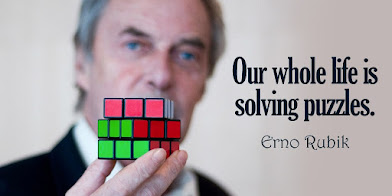The Rubik’s Cube, the geometric puzzle created in 1974 by a Hungarian architecture professor, striving to help his students understand 3D geometry. The Cube has 43 quintillion possible positions and exactly one correct solution, which at the moment feels about as close as the nearest star.
The Rubik’s Cube became one of the most popular toys in history, with
more than 350 million sold to date.
Sometimes life looks like a big mess—but God is always
working, and He will make things right in the end.
When solving a Rubik's Cube, one
must focus. ... While solving a Rubik's Cube, as noted by Hobby
Inspired, the brain cells are kept activated. The cube also
improves the brain's cognitive mapping skills.
Life
is like a Rubik's Cube. Sometimes all the squares line up and sometimes they just
don't!"
Life is similar to
Rubik's Cube. It's not complete all the time. In most cases, it's scrambled.
What we enjoy, is the process that turns it from disordered to ordered. This
process is colorful and astonishing.
Critical lessons Rubik’s cube teaches us.
Improves
problem-solving
Life is about problem-solving. The basis for this skill is breaking an issue
down into smaller parts and addressing each item one by one. With over 43
quintillion options to twist and turn, the Rubik’s Cube could be thought of as
a mini plastic universe. When you sit and solve the puzzle, you must focus and
turn each section, while realizing that every twist affects subsequent moves. Puzzlers
may be able to find the solution for how to solve a Rubik’s cube, but people
who like real challenges love to come up with their own. These are the world’s
creative problem solvers.
Improves patience
Face it. This puzzle requires perseverance. It could take hours to solve, or it
could end up on a shelf. People who work at this must sit, think, and twist.
Then sit, think, and twist again and again. Of course, solving a problem like the cube can lead to a great sense of
satisfaction and accomplishment. When faced with future tasks that are
difficult and time-consuming, cubers have the confidence to tackle the job and
complete it.
Shortcuts lead you nowhere.
To solve the Rubik’s cube, you need to follow the particular set of steps. You can’t skip one and finish solving the cube. There are no shortcuts here. Likewise, there are no shortcuts in life. If you wish to reach somewhere, you need to follow the steps. Shortcuts might look easy, but they won’t take you near your destination.
Improves concentration and
configuration
When solving a Rubik’s Cube, one must focus. Living in the digital age of
flashing screens and beeping phones, it is becoming harder to concentrate on
one task for a long time. While solving a Rubik’s Cube, as noted by Hobby Inspired, the brain
cells are kept activated.
The
cube also improves the brain’s cognitive mapping skills. The Rubik’s cube is an
instance of what’s called a configuration problem, the best-known example of
which involves finding the most efficient way to reorganize boxes stacked in a
warehouse.” Go configure!
Practice makes progress.
“Practice makes progress,” on the other hand, is a philosophy that encourages and acknowledges improvement in any capacity. As with many things in life, fitness should be viewed as a marathon, not a sprint.
The process of finding a solution or discovering an
addition to mankind, the process of critical planning, launching, branding,
executing, failing and fighting back.
Similarly in life, you have to ruffle things up
once in a while. You need to get out of your comfort zones, give up those
personal silos you have created, and take risks if you want to win the war.
Things only get better after they get worse. solving cube is similar to life
because you go by an algorithm! Life is difficult. But you must persevere.



No comments:
Post a Comment